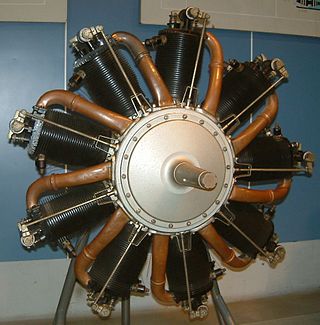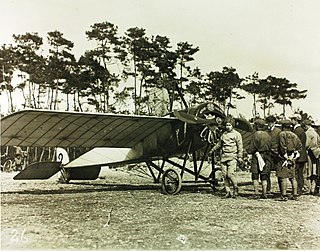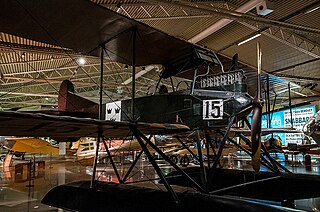For the aircraft Thulin Type B see:Thulin B (aircraft)
Thulin B or Thulin Type B was an automobile built by AB Thulinverken.
In 1925 Thulinverken was contacted by the brothers Per and Hugo Weiertz (who earlier had worked on the Self) who wanted them to build a car using their own blueprints. Thulinverken became interested in the project and hired the two brothers. During 1926 a prototype was constructed and tested and during 1927 the car went into production. Only 13 cars were built and none of them remain today.

The rotary engine is an early type of internal combustion engine, usually designed with an odd number of cylinders per row in a radial configuration. The engine's crankshaft remained stationary in operation, while the entire crankcase and its attached cylinders rotated around it as a unit. Its main application was in aviation, although it also saw use in a few early motorcycles and automobiles.

The Bristol Aeroplane Company, originally the British and Colonial Aeroplane Company, was both one of the first and one of the most important British aviation companies, designing and manufacturing both airframes and aircraft engines. Notable aircraft produced by the company include the 'Boxkite', the Bristol Fighter, the Bulldog, the Blenheim, the Beaufighter, and the Britannia, and much of the preliminary work which led to Concorde was carried out by the company. In 1956 its major operations were split into Bristol Aircraft and Bristol Aero Engines. In 1959, Bristol Aircraft merged with several major British aircraft companies to form the British Aircraft Corporation (BAC) and Bristol Aero Engines merged with Armstrong Siddeley to form Bristol Siddeley.

The Albatros B.II, was an unarmed German two-seat reconnaissance biplane of the First World War.

The Morane-Saulnier L, or Morane-Saulnier Type L, or officially MoS-3, was a French parasol wing one or two-seat scout aeroplane of the First World War. The Type L became one of the first successful fighter aircraft when it was fitted with a single machine gun that fired through the arc of the propeller, which was protected by armoured deflector wedges. Its immediate effectiveness in this role launched an arms race in fighter development, and the Type L was swiftly rendered obsolete. The original Type L used wing warping for lateral control, but a later version designated Type LA was fitted with ailerons.

The Bugatti Type 41, better known as the Royale, is a large luxury car built from 1927 to 1933 with a 4.3 m (169.3 in) wheelbase and 6.4 m (21 ft) overall length. It weighs approximately 3,175 kg (7,000 lb) and uses a 12.763 litre (778 cu in) straight-eight engine. For comparison, against the Rolls-Royce Phantom VII, the Royale is about 20% longer, and more than 25% heavier. This makes the Royale one of the largest cars in the world. Furthermore, with the limited production run and the premium nature of the vehicle, it is also both one of the rarest and most expensive vehicles in the world.
AB Thulinverken was a company in Landskrona, Sweden, founded in 1914 as Enoch Thulins Aeroplanfabrik by the airman and aircraft designer Dr. Enoch Thulin. The company became Sweden's first aircraft manufacturer. In 1920, Thulin also started manufacturing automobiles, which continued until 1928. During World War I, the company came into financial difficulties and was reconstructed in 1922 as AB Thulinverken. The manufacturing of brake systems became a main focus of the company. In 1958, Thulinverken merged with Svenska AB Bromsregulator. The remains of Thulinverken are now a part of SAB Wabco AB, which is owned by the French Faiveley Transport company since 2004.
HB was a car made in two or three copies at Berglunds mekaniska verkstad at about 1925. On the prototype they used a three-cylinder engine, but the production models had a four-cylinder engine producing 16 horsepower. The engine was connected to a three-speed transmission. The car was a two-seater, and the design was much inspired by the Thulin A by AB Thulinverken. The company was later renamed to Sörby mekaniska verkstad (SMV) and made travel trailers.
Self was a series of three cyclecars built by the brothers Per and Hugo Wiertz in Svedala in 1916, 1919 and 1922.

Le Rhône was the name given to a series of rotary aircraft engines built between 1910 and 1920. Le Rhône series engines were originally sold by the Société des Moteurs Le Rhône and, following a 1914 corporate buyout, by its successor company, Gnome et Rhône. During World War I, more than 22,000 nine cylinder Le Rhône engines were built, with the type far outselling Gnome et Rhône's other main wartime engine series, the Gnome Monosoupape.

The Thulin LA was a Swedish two-seat, single-engine biplane designed by Enoch Thulin in 1917 and made by his company AB Thulinverken in Landskrona. It was based on the earlier Thulin L and E aircraft, with a new engine, fuselage and empennage. The L and E types were in turn based on the German Albatros B.II aircraft, like the NAB Albatros. The Thulin LA was used in Sweden, the Netherlands (10) and Finland (1). This type also made the first passenger transport flights between Sweden and Denmark in 1919. Altogether there were 15 Thulin LAs built.
The Benz Bz.III was a six-cylinder, water-cooled, inline engine developed in Germany for use in aircraft in 1914. Developing 112 kW (150 hp) at 1,400 rpm from 14.3 L, it powered many German military aircraft during World War I. It was replaced in production by the unrelated Benz Bz.IIIa. and eventually the V-8 Benz Bz.IIIb. The Benz Bz.III was built under licence in Sweden by AB Thulinverken, known as the Thulin E.

Aéroplanes Voisin was a French aircraft manufacturing company established in 1905 by Gabriel Voisin and his brother Charles, and was continued by Gabriel after Charles died in an automobile accident in 1912; the full official company name then became Société Anonyme des Aéroplanes G. Voisin. During World War I, it was a major producer of military aircraft, notably the Voisin III. After the war Gabriel Voisin abandoned the aviation industry, and set up a company to design and produce luxury automobiles, called Avions Voisin.

Haldex AB, also known as Haldex Group, is a Swedish public company operating in the commercial vehicle industry. It is listed on the OMX Stockholm Stock Exchange, and has an annual turnover of around 4.4 bn SEK.

The Morane-Saulnier G was a two-seat sport and racing monoplane produced in France before the First World War. It was a development of the racing monoplanes designed by Léon Morane and Raymond Saulnier after leaving Borel and, like its predecessors, was a wire-braced, shoulder-wing monoplane. Construction was of fabric-covered wood throughout, except for the undercarriage struts which were of steel tube.
The Thulin K was a Swedish naval fighter aircraft in the 1910s. It was operated by both the Swedish and Dutch armed forces.

Enoch Leonard Thulin, is primarily remembered as a pioneer of the Swedish aircraft industry. He was an engineer who also worked on cars, lorries and internal combustion engines.

The automotive industry in Sweden is mainly associated with passenger car manufacturers Volvo Cars and Saab Automobile but Sweden is also home of two of the largest truck manufacturers in the world: AB Volvo and Scania AB. The automotive industry is heavily dependent on export as some 85 percent of the passenger cars and 95 percent of the heavy vehicles are sold outside of Sweden. The automotive industry and its sub-contractors is a major part of Swedish industry. In 2011 around 110,000 people were employed and the export income of 150 billion SEK accounted for 12 per cent of Sweden's export income. During 2009 128,738 passenger cars and 27,698 heavy vehicles were built in Sweden. Koenigsegg is also a famous swedish company which makes some of the fastest cars in the world, but also some of the most expensive. They currently produce models such as the Jesko, Gemera, and CC850.

The Thulin G was a Swedish military reconnaissance aircraft built in the late 1910s.

The Thulin NA was a prototype Swedish fighter plane built in the late 1910s.